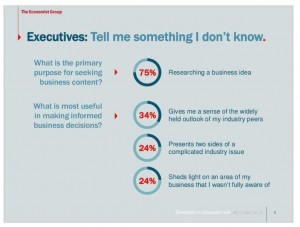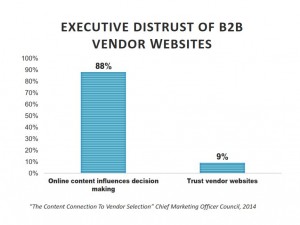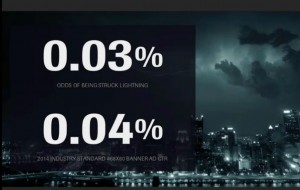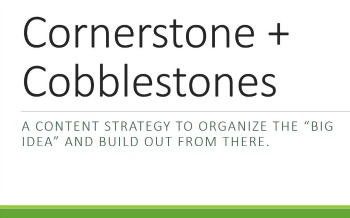We talk a lot about content marketing.
Of course, the “quality” of said content also matters. And quality is sometimes hard to quantify. (There is an “I’ll-know-it-when-I-see-it” element to quality.)
There’s another element we don’t talk about enough: trustworthiness.
I was on a MarketingProfs Webinar recently on Creating Trustworthy Content. Gerry McGovern, who thinks a lot about online ecosystems, talked about the disconnect between content creators (i.e., brands and their marketers) and content consumers. In it, he cited an Economist Group survey that found that executives are looking for content providers to tell them something they don’t know. Specifically:

Marketers, meanwhile, just want to sell. McGovern said they’re saying “look at us, aren’t we awesome.” So while decision makers are looking for Web content to help them make buying decisions, only a tiny fraction actually trust corporate content. (Yes, it is ironic.)

Don’t be this Web site.
Instead of telling me about your awesome product, tell me why I should care. Or, better yet, be awesome. That way other people–your customers–will tell me for you. As McGovern put it, “Social media is much more about me and my friends. Not me and my brands.”
This last point is key.
There has been a paradigm shift away from advertising and toward word-of-mouth. While this isn’t “new” in 2015, it’s clear that lots of organizations still don’t understand how to act on this shift. Why else would so little company-generated content be seen as trustworthy?
Focus on your customer.
And this brings me to the Achilles heel of marketing.
McGovern said that the Achilles heel of marketing is “our orientation to sell to the potential customer and ignore the existing customer.”
He’s right. Many businesses have it backwards. McGovern cited several examples of companies that re-oriented their content around what customers want and reaped the benefits:
–A pool company saw a huge jump in revenue after it started providing details about products and pricing — both its own and that of its competitors.
–A cancer society achieved a 70-percent increase in one-time donations after it removed the donate button from its home page in favor of information about treatments, symptoms, and research.
–A bank reaped a 520-percent increase in traffic to its product pages after it removed those links from the home page and focused the landing page instead on making it easy for existing customers to log in.
Useability is the new sales.

According to McGovern, we’re as likely to be struck by lightning as to click on a banner ad.
Annoying us doesn’t work.
Perhaps the bigger failure (and weakest link) is equating marketing with selling. So we think about what we want people to know versus what they want to know from us. Is it any wonder that the end result too often is content that is neither helpful nor trustworthy?
Give the people what they want. When you focus on your customers (or clients, members, patients, and so forth), the results will follow.



